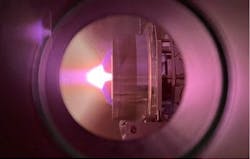Phase Four to launch monopropellant multimode propulsion system for satellites
HAWTHORNE, Calif. – Phase Four in Hawthorne, Calif. announced its plans to commercialize its monopropellant multimode propulsion technology, using its Maxwell Block III thruster to enable satellites to operate on either ASCENT or hydrazine chemical propellants.
The company’s multimode system provides high thrust through chemical propulsion combined with the efficiency of electric propulsion, both powered by a single propellant. Phase Four's radiofrequency (RF) thruster supports the integration of chemical propellants, allowing for this dual-mode functionality. Upcoming ground demonstrations of the technology using ASCENT and hydrazine-based systems are planned in partnership with the Department of Defense and private sector partners by the end of Q1, 2025.
Hydrazine, widely used in commercial applications, and ASCENT, a non-toxic propellant developed by the Air Force Research Laboratory (AFRL), have key differences in safety and handling protocols. ASCENT offers comparable performance to hydrazine but without the extensive handling requirements, potentially enhancing operational efficiency.
Related: Phase Four unveils Maxwell plasma thruster for smallsats
A notable feature of the Maxwell Block III thruster is its true monopropellant capability, which operates entirely on chemical propellants, eliminating the need for auxiliary xenon or krypton tanks common in other systems. This simplifies design and reduces weight and cost. The system addresses challenges in the industry, including reliance on xenon and krypton, which face supply chain issues that impact economic and security concerns.
Umair Siddiqui, President and CTO of Phase Four, emphasized the innovation, saying, "At Phase Four, we've been refining the state-of-the-art electrodeless RF thruster for nearly a decade. The absence of a hollow cathode allows our thruster to handle propellants like hydrazine and ASCENT more effectively than traditional electric propulsion systems. We are excited to demonstrate this capability through direct integration with live propellants, in collaboration with the Department of Defense and leading chemical thruster suppliers."
